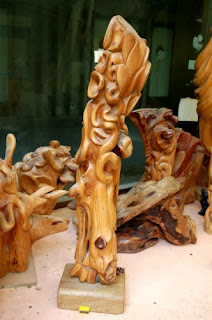When I saw the sign leading to the entrance of the doll house, downtown picturesque l'Isle sur la Sorgue, in Provence, it didn't quite occur to me that I was going to visit it. I'm just not that "into dolls", I tried to explain to my aunt who, on the other hand, seemed very excited about it. "Come on, we're grown-ups!" I argued, trying in vain to talk her out of what it looked like a waste of our time.
I should have known better that when my aunt has something in mind, there's nothing anybody can do to stop her. She's my mother's sister, after all.

As soon as we crossed the threshold between modern world and that yesteryear playground, I became aware it wasn't going to be a children leisure activity and I wasn't going to be faced with Barbie & Co.. The lady welcoming the museum's visitors seemed to have spent all her life among her dolls, I'm sure she intimately knew them. She gave us our tickets and introduced us to her fancy world: "You can start from here," she said, pointing the entrance of the main hall. "If the glass is a problem for your pictures, I can open the display cabinets."
We motioned forward and we glanced at each other. We didn't say anything, but we both thought: "Are we sure these were aimed at little girls?"
The dolls I was photographing looked unnervingly like real children, everything about them looked real: their eyes, their teeth (yes, we could see their teeth), their hair. We felt like they were looking at us, that if it was quiet enough we could hear them whisper.

In the first hall, the doll that most impressed me was lying on her bed, I think she belonged to a rich family, but she looked pretty much like a little dead body to me. Although the old-fashioned playground was already rather creepy, only as we moved forward things started being seriously scary.
There was a narrow area crammed with dolls of every size, colour, feature, facial expression. Some looked bored, others annoyed by the too many strangers, others just giving us a blank glance. "Oh, ça serait la nursery!" it was pointed out to us. We weren't actually allowed in the nursery (not that we wanted to), we could only look from the adjacent room, the one housing the "fashion-dolls".
The lady apparently liked us (or saw us quite lost) and decided to abandon her usual position at the entrance to follow our wandering through toyland. "These are very pretty," she explained pointing at the fashion-dolls, "and also their dresses are quite precious because they served as models for tailors and fashion designers of their time." Nonetheless.

We thought we had seen everything, until we entered the last room. At the very back, near the radiator and behind a small sofa, almost hidden away from her peers, the creepiest doll was standing seemingly ready to escape. She seemed she had just stopped bleeding, her white dress looked old and worn-out. "Gosh," I thought. "Has she fought the French Revolution?" My thoughts were diverted by my aunt's chuckle: "Doesn't she look like the doll killer of that famous horror movie??" Oh my,
Child's Play.
With the hope not to have nightmares when sleeping, we proceeded towards the end of our journey. After having thanked the lady for being at our disposal, my aunt told her with a hint of mystery: "I could never stay here overnight..." "Really??" she retorted innocently, "many people have told me that, I don't understand why!"
We left the lady with her dolls and we got back to the modern world, wondering if the picturesque town was holding more surprises.




























